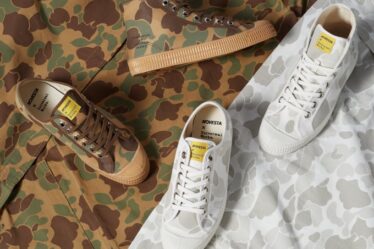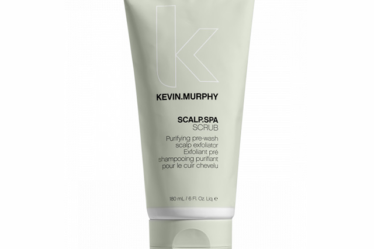
The Preppy aesthetic is a visual construct comprising British-inspired patterns (tartan, argyle, gingham, glen check) in muted colors and high-quality natural materials like cotton, wool, and leather.
The Preppy aesthetic elements (patterns, colors, visuals, textiles, are the foundation of the Preppy style.
As such, Preppy aesthetic elements are always present in the style’s core clothes and accessories, such as polo shirts, blazers, and loafers.
Each Preppy aesthetic element depicts aspects of the subculture’s roots, values, and lifestyle.
The choice of high-quality and natural materials reflects an appreciation for durability and classic, traditional dressing style.
The nautical and countryside colors reflect an appreciation for leisurely outdoor pursuits, and the school-inspired uniforms are a nod to the subculture’s origin in elite education, signifying respect for heritage and formality.
The Roots of Preppy Aesthetic
The Preppy aesthetic, present across the entire Preppy fashion movement and specific Preppy styles of dressing, is rooted in British, Scottish, and Irish cultures.
The Preppy aesthetic elements are a standard part of students’ uniforms at the country’s elite educational institutions like Oxford, Eton, and Cambridge.

In the 1800s, the British-inspired aesthetic was adopted by American private preparatory schools and colleges like Harvard, Yale, and Princeton.
Origin of Preppy Visuals and Aesthetics
There are 3 main areas credited with the creation and evolution of the Preppy subculture and, therefore, the American Preppy aesthetic and dressing style:
Ivy League Preppy Aesthetics
With a rich colonial past, Atlantic coastline, sailing, and seaside activities, New England’s nautical-themed colors, patterns, and boat shoes significantly create the Preppy aesthetic and visuals.


Inspired by nautical explorations, this facet of the Preppy aesthetic comprises visuals like anchors, compasses, ships, lighthouses, stripes, whales, and hydrangeas.
And, in line with the students’ collegiate uniforms, the Ivy League Preppy aesthetic consists of navy blue, forest green, crimson, black, and white, reflecting local activities such as sailing or horse riding.
Northern Preppy Aesthetics
Neighbour to New England but with a colder climate, the Northern Preppy aesthetic (from the Upper Midwest) includes duck boots, heavy sweaters, and layered outfits in darker shades, more suitable for the outdoor lifestyle.
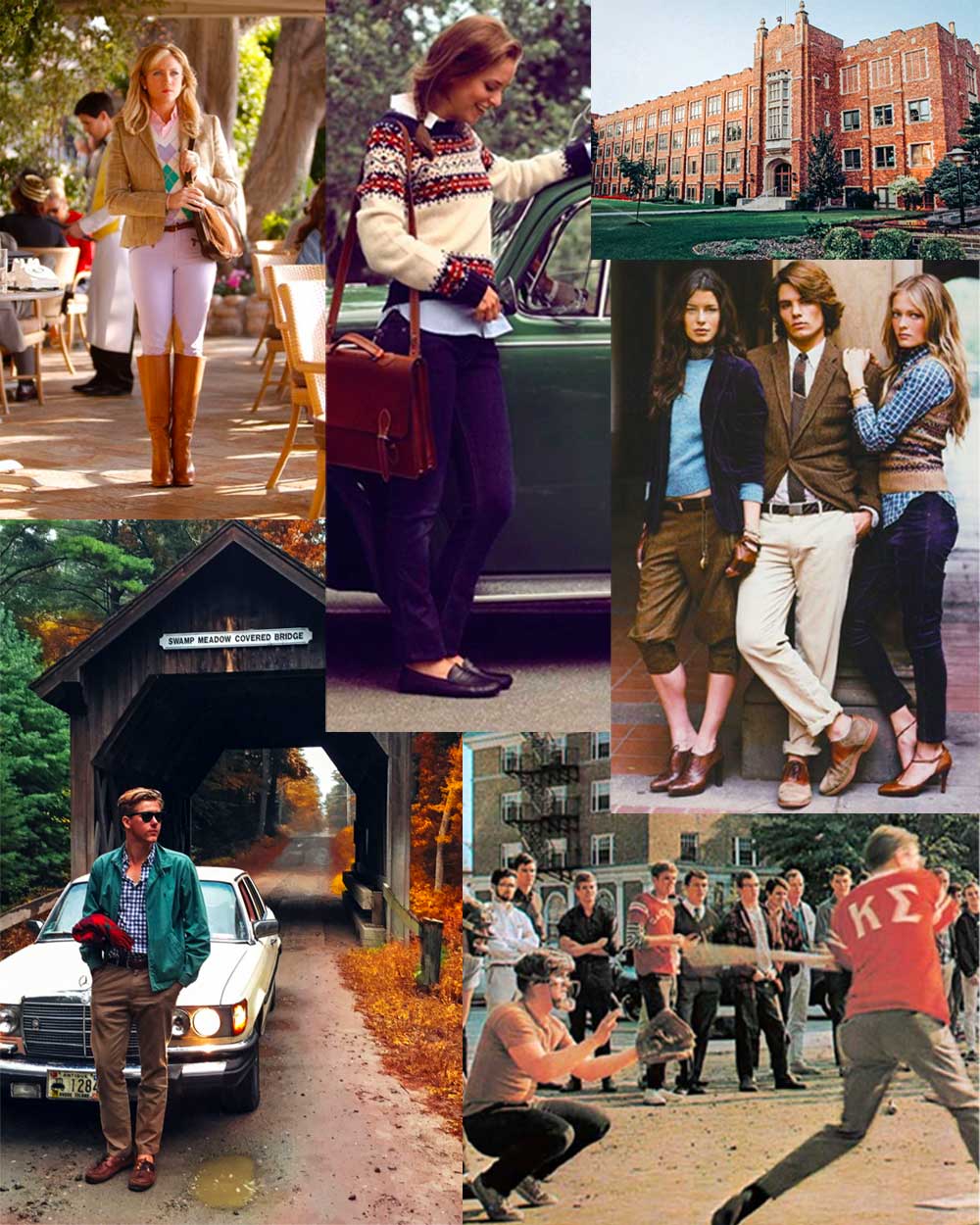

Patterns like stripes, plaids, and tartan checks are prevalent in this Preppy aesthetic variation, echoing the uniforms of elite British schools and traditional fashion.
The most popular colors in the Northern Preppy are white, navy, blue, dark blue, emerald green, aqua, coral, olive green, beige, browns, tan, dark red, and black.
Southern Preppy Aesthetics (American South)
The American South’s warm and humid climate gave birth to unique aesthetics and colors such as gingham, madras, Nantucket red, wide-brimmed hats, cowboy boots.
Inspired by land explorations, the Southern Preppy aesthetic comprises visuals like palm trees, elephants, monkeys, zebras, polka dots, and florals, as seen in Lilly Pulitzer‘s designs.
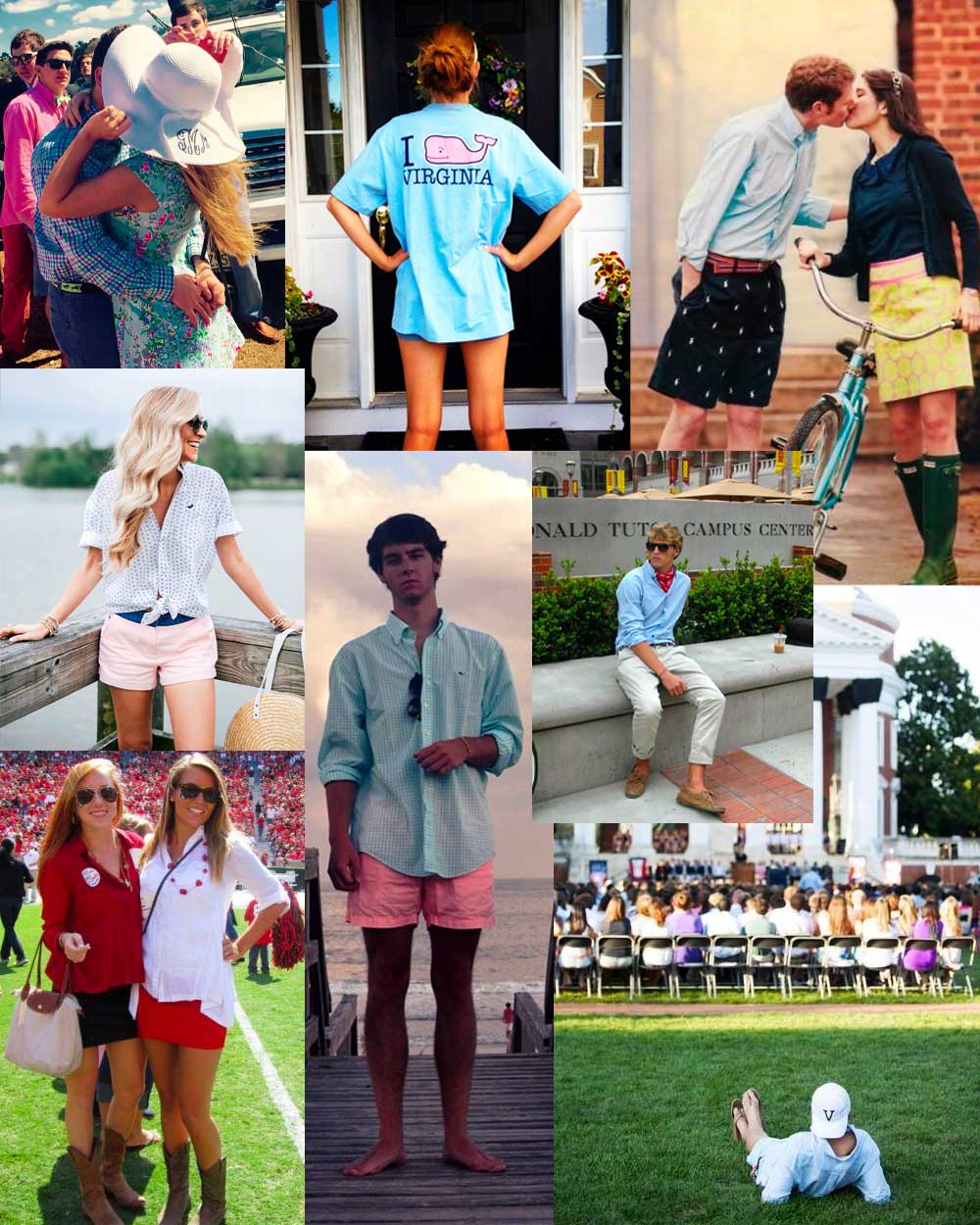

Patterns like florals, madras, gingham, buffalo checks, and polka dots are prevalent in the Southern Preppy, while colors like light greens, yellow, orange, pink, and turquoise are most popular.
As a comparison, the New England Preppy aesthetic balances academic formality with nautical elements, while the Upper Midwest and Southern Preppy versions have aesthetics in line with the related climates and outdoor activities.
Preppy Aesthetic Constituent Parts
The Preppy Aesthetic comprises characteristic patterns such as plaids, gingham, madras, plaids, and argyle, materials like cotton, wool, cashmere, and representative colors.
Preppy Patterns
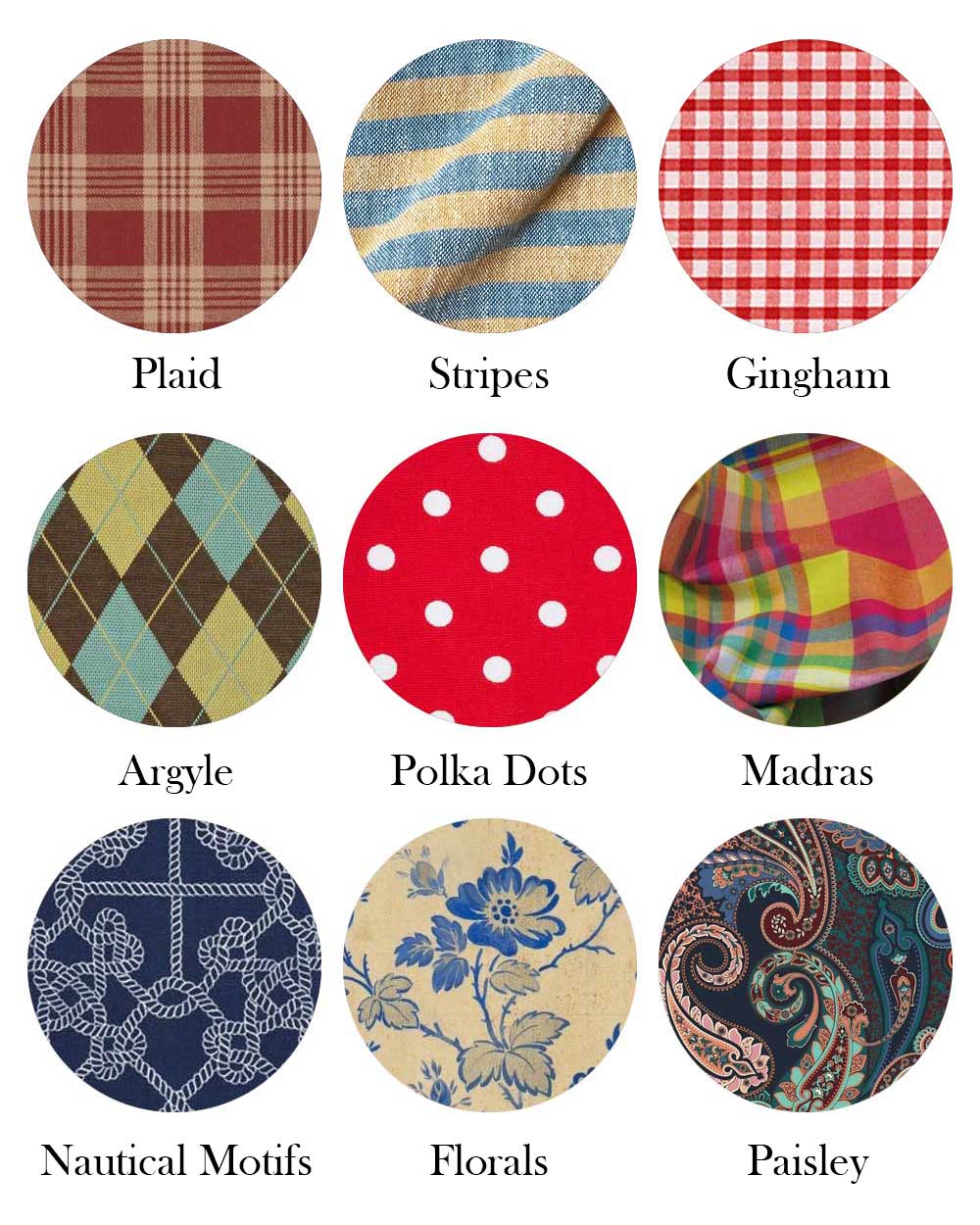

Some of the most iconic patterns representing the Preppy aesthetic are:
- Plaid: Originating from Scottish tartans and used in British school uniforms, plaid became a popular Preppy aesthetic element thanks to its association with heritage and tradition. Plaid is most often used in skirts, trousers, and scarves.
- Stripes: Often in navy blue and white, as a reflection of the nautical influence, stripes can be seen on boat neck tees, repp ties, or rugby shirt stripes and are a cornerstone Preppy pattern.
- Gingham: The checkered pattern has roots in British countryside fashions and was adopted by the American Preppies in shirts and dresses.
- Argyle: The Scotland diamond-shaped pattern is critical to the Preppy culture and is used in golfing sweaters, socks, and hats, reflecting the community’s continental heritage and connection to sports.
- Polka Dots: Polka dots are a classic pattern found in many fashion styles, used by Preppies for a touch of femininity in women’s clothing and accessories.
- Madras: Originating from Madras (now Chennai), India, the colorful checked pattern became a famous mid-20th century in Preppy summer wear.
- Paisley: An intricate Persian pattern that became popular in the West by importing Indian textiles. In preppy fashion, paisley is used in ties and scarves for a touch of elegance and exoticism.
- Nautical Motifs: Used particularly in Preppy aesthetic room decors, thematic patterns like anchors, sailboats, and ropes reflect the preppy style’s ties to coastal leisure activities and are used in casual summer wear and accessories.
- Florals: While less common than the other patterns mentioned above, floral patterns are found in Preppy women’s and spring and summer clothing.
- Seersucker: Not a pattern per se, but a fabric, suits from Seersucker are a staple Southern Preppy, thanks to the material’s lightness and breathability.
Preppy Textiles and Materials
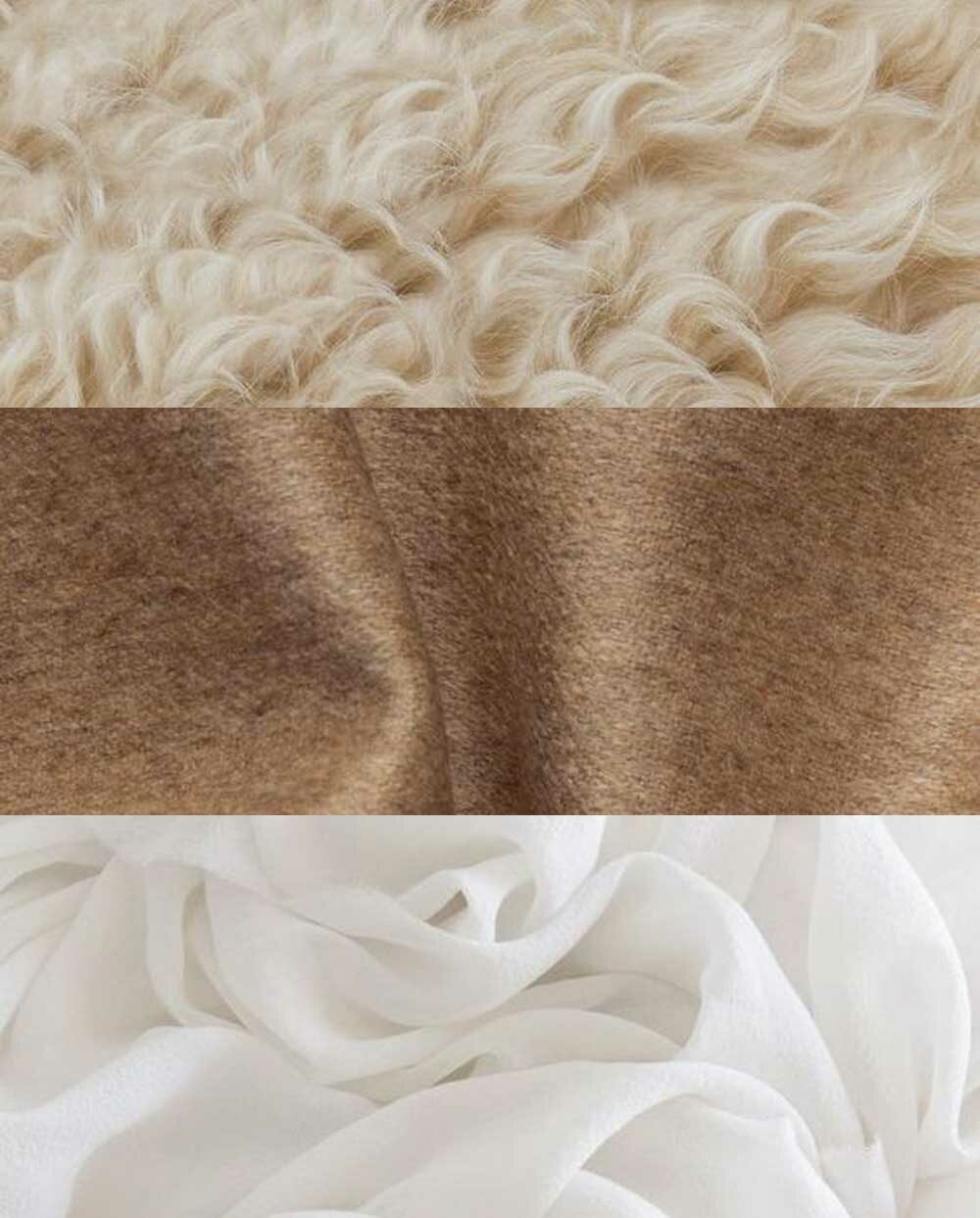

Natural materials of high quality like wool, cashmere, cotton, and classic Oxford cloth are critical to the Preppy aesthetic.
Tweed, flannel, and Seersucker are also used for extra texture and visual interest.
Preppy Colors
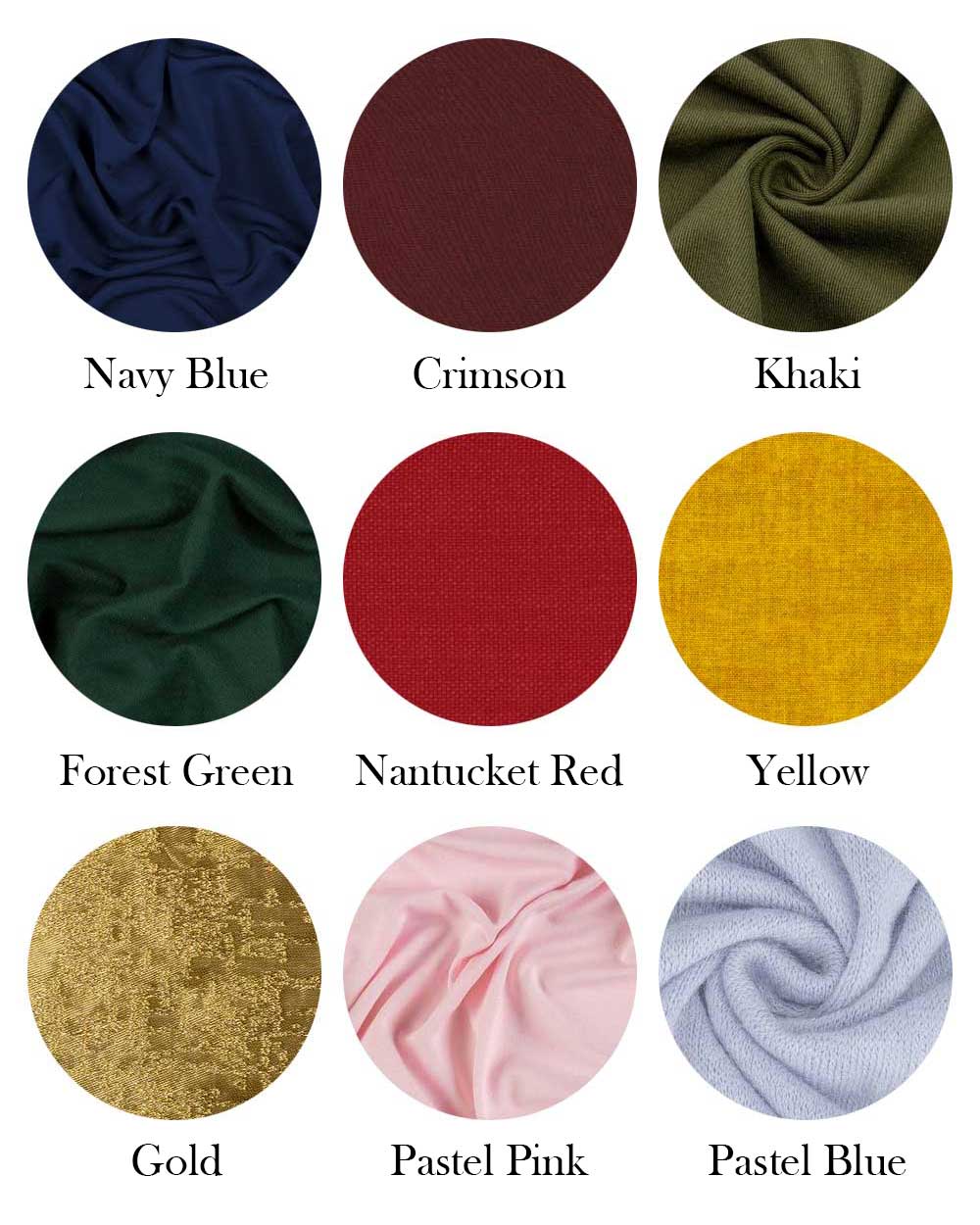

According to the Preppy subculture’s origins and evolution, some colors are quintessential to the Preppy aesthetic.
Over the years, trends have come and gone, but these Preppy colors have remained constants in the Preppy aesthetic and subculture.
Each Preppy color presented above has ties to Preppy origins, values, and activities, such as an appreciation for the outdoors, sports, academic endeavors, and a balance of formality and casualness.
- Navy Blue: As a dominant color in school uniforms, formal wear, and naval attire, navy blue is a staple Preppy color.
- Crimson: Deep red is another key Preppy color associated with some Ivy League institutions, notably Harvard.
- Khaki: Predominantly found in chinos, khaki reflects the influence of military attire and is a staple color of the Preppy style.
- Forest Green: Deep greens are associated with outdoor leisure activities like golfing and hunting, which are popular among the upper class. The green color also ties to the environmental colors of the Ivy League campuses.
- Nantucket Red: Salmon pink is a hallmark Preppy color, originating from the trousers sold in Nantucket’s Murray’s Toggery Shop. The trousers fade with wear to a distinctive washed-out pink, symbolic of leisurely summers on the New England coast.
- Yellow: As a color reflecting the vibrancy and positivity of the Preppy style, yellow is often found in polo shirts and Preppy summer dresses. Yellow has an ‘always sunny,’ optimistic connotation, which aligns with the Preppy subculture’s association with leisure, positivity, and happiness.
- Gold: Inspired by the brass buttons on traditional navy blazers, gold is the color of choice for Preppy accessories (gold cufflinks, rings, earrings, watches) and signifies tradition, luxury, and sophistication.
- Pastels: Light pink, sky blue, and mint green pastels became popular in the 1980s during the “peak preppy” period and continue to be associated with the Preppy aesthetic.
- Black: While not as prevalent as the other Preppy colors, black is used in evening wear for formal events, reflecting the influence of traditional tuxedos.
- White: From tennis outfits to Oxford shirts, white is a crucial Preppy color used to confer stylistic versatility and a timeless appeal.
Weekly Newsletter
Keep up with the latest in fashion, beauty and style!
Professional Styling Advice
Are you looking to improve your fashion style, try some new attire, tailored or bespoke outfits, and even some haute couture creations, and don’t know where to start? We’re here to help!
Contact The VOU’s Style Experts to receive your free and personalized styling advice based on your current way of dressing, preferred outfits, colors, aesthetics, age, gender, body shape, location, and event you seek to attend.
Your dedicated stylist will meticulously select essential garments, footwear, and accessories to craft a wardrobe that complements and enhances your style.
Take advantage of this unique opportunity to experience a transformative fashion adventure, all at no cost to you.
After years of managing hundreds of fashion brands from London’s office of a global retailer, Mandy has ventured into freelancing. Connected with several fashion retailers and media platforms in the US, Australia, and the UK, Mandy uses her expertise to consult for emerging fashion brands create top-notch content as an editorial strategist for several online publications.


